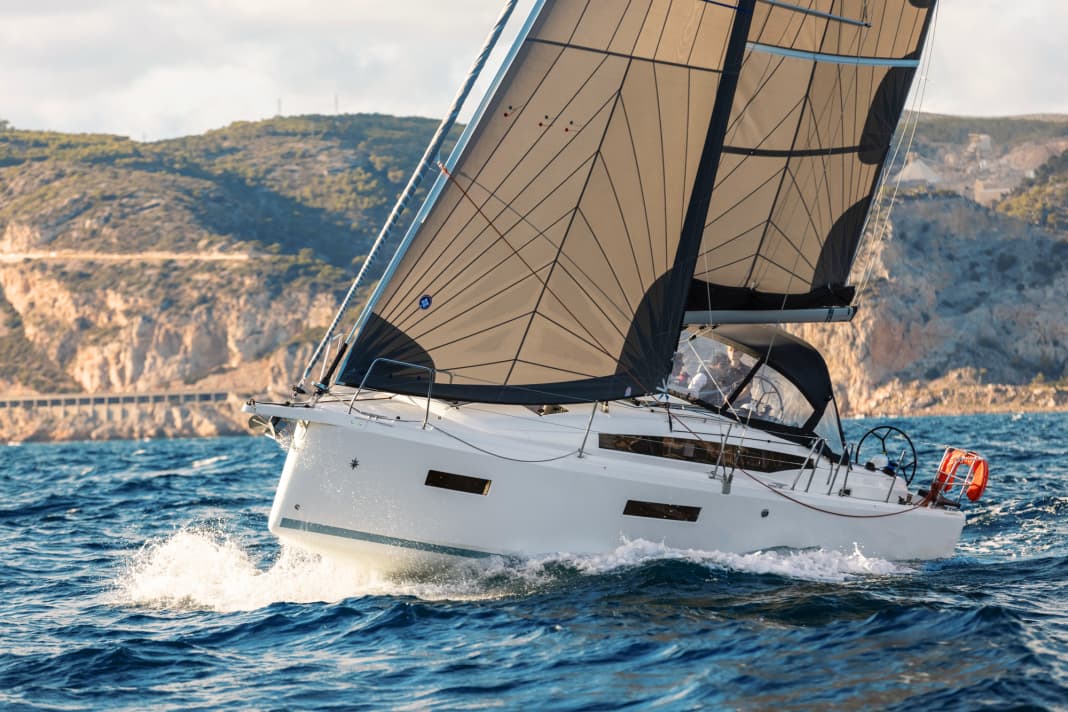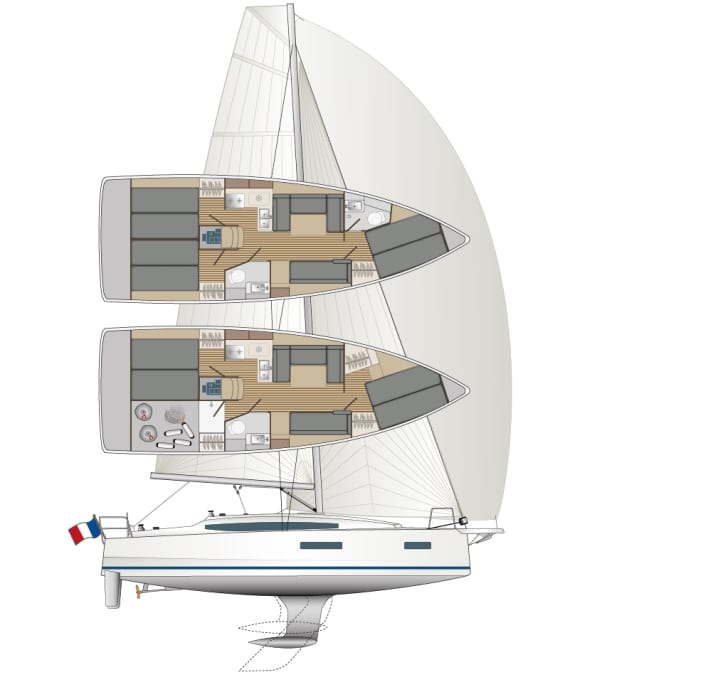





The particularly straightforward expansion of the programme is and always has been Jeanneau Yachts' hobbyhorse. Hardly any other shipyard develops and revises its product ranges as consistently and sustainably as the French yacht builders in the Vendée. This is especially true of the Sun Odyssey touring range. Most recently, the French launched a completely new and conceptually homogeneous product cycle with the highly acclaimed Sun Odyssey 440. This was combined with a very interesting novelty: the so-called walkaround cockpit, until then a real innovation for cruising yachts of this type.
The idea behind the arrangement, which is as idiosyncratic as it is inventive, is that the side gangways slope steplessly from the centre of the ship like ramps down to the level of the cockpit floor. This creates a kind of channel between the cockpit coaming and the overhanging hull, a kind of stepless passageway from the cockpit to the side deck. The Sun Odyssey 440 was awarded the title of European Yacht of the Year 2018 for this well thought-out innovation, which worked very well during testing. Jeanneau subsequently successfully implemented the same feature on the larger Sun Odyssey 490 and the smaller twelve-metre Sun Odyssey 410.
Competitors
The Sun Odyssey 380 has the walkaround cockpit
The Sun Odyssey 380, like all of Jeanneau's smaller boats designed by Marc Lombard, replaces the Sun Odyssey 389 (formerly 379), a boat that has been on the market with modifications since 2011, with strong sales as an owner's boat as well as for use in yacht charters. In addition to the walkaround cockpit, which is probably the most significant modification, Sun Odyssey 380 also has some other exciting new features to offer compared to its successful predecessor.
Jeanneau's Sun Odyssey 380 is now available in a version with a swivelling keel, which is apparently increasingly in demand. The hydraulically retractable fin had previously only been offered by the shipyard for the smallest model, the Sun Odyssey 349. Together with the standard double rudder blades, the two small boats in Jeanneau's touring programme are therefore suitable for dry-docking, but only with the use of wading props, which are quite complex to fit. The basis, however, remains the fixed keel made of cast iron in an L-shape with ballast bomb, which is available with two draughts.
No backstay on the Sun Odyssey 380
The rig concept is also new. The comparatively high mast with two extremely steeply swept spreaders is set with a strikingly high mast drop. The aft tilt is around 4 degrees, which is quite a lot and really striking. In this way, the product developers want to ensure that the forestay engages with the mast at a smaller angle and can therefore be better controlled by the stay with increased shroud tension and mainsheet tension.
In return, the backstay can be dispensed with completely without having to neglect the sail trim. This is particularly pleasing for the helmsman, who has more freedom of movement in his working area, both standing and sitting, thanks to the lack of wire pulls at the stern of the Sun Odyssey 380. On the larger sister Sun Odyssey 410, on the other hand, the double-guided backstay hinders the helmsman, especially in a sitting position.
The main boom is set very low at the front of the mast. This may look strange and perhaps even unsportsmanlike from a distance, but it has the significant advantage that the mainsail can be reached at a good height and can be easily hoisted into the lazybags. The slender, high mainsail with a rectangular top boom and the short overlapping genoa with 3D hoisting points define the sporty equipment standard. Cruising sailors can optionally order their boat with a furling mast and/or self-tacking jib.
The Sun Odyssey 380 is sporty to sail
The test under sail took place in variable conditions off Barcelona in Spain, where the Sun Odyssey 380 had to face the international jury for Europe's Yacht of the Year 2022. In initially calm conditions with only 8 knots of wind, the Sun Odyssey 380, which is quite light compared to the competition, got underway quickly and well, reaching 5.6 knots close-hauled and tacking at an angle of 90 degrees. Later, with more wind around 16 knots and a fairly high swell, the French yacht developed even more momentum, running at a pleasing 40 degrees to the wind and reaching 6.7 knots over ground.
The Sun Odyssey 380 also sailed noticeably stiff and upright on all courses. The high dimensional stability is primarily due to the wide hull with its very distinctive chine and the flat bulkhead in the underwater hull. However, it should be mentioned that the test yacht, construction number 1, was equipped with the optional swivelling keel. The variable appendix has an impressive draught of 2.70 metres when fully lowered, but has a slightly lower ballast ratio. According to the polar data (VPP), at 4 to 5 Beaufort the swing keel version offers a performance advantage of around 0.4 knots in the wind compared to the boat with a standard deep keel.
The control system is simple. A continuous chain and rope hoist is connected directly to the push rod, which couples the quadrants below deck. This mechanism is the tried and tested standard on all smaller Jeanneau and Beneteau boats under 40 feet hull length. Although the system is not redundant, it is easily accessible through large maintenance hatches in the aft cabins. And the autopilot is directly connected to a rudder quadrant and guarantees controllability in the event of a system fault. The advantage of the simple mechanics on the Sun Odyssey 380 is its very smooth steering behaviour. Particularly in strong winds and waves, the French yacht can be steered with ease and a great feeling for the pressure on the rudders; steering is a pleasure.
The Jeanneau is suitable for single-handed sailing
The sheets for the mainsail and genoa lead over the coaming on both sides to the winches in front of the helm stations. The helmsman can easily reach these from his position, as can the crew from the cockpit. You can work on the winches in an exemplary manner, with strength and at an ergonomically sensible height, standing sideways in the recessed channel of the walkaround cockpit. The halyards and trim lines are operated at the front on the side of the companionway.
Two cockpit lockers keep the cockpit of the Sun Odyssey 380 organised. Larger items such as fenders or additional sails can be stored in the aft peak. There is also a closed storage space in the stern for the life raft, which can only be accessed when the stern platform is open. Incidentally, this is only available as an option and at extra cost, which should be questioned. The bathing hatch is actually an essential part of the boat as a safe stern closure, precisely because the steering pedestals are mounted very far aft and the walkaround concept even dictates the round trip from the cockpit around the helm stations.
Variable below deck
Looking at the interior layout, one detail on the Sun Odyssey 380 is particularly eye-catching: the double berth built into the side of the foredeck at an angle. This rare arrangement allows Jeanneau to create more space on the opposite side for an additional toilet room, which, judging by the plans, is significantly larger than on competitor boats and also has a shower facility. An additional wet room in the foredeck as an option is now standard in the 38-footer class. The disadvantage of the diagonally installed berth is the modest berth dimensions in comparison. The berth is just 1.37 metres wide at the height of the shoulders, which is well below the class average. On the other hand, the bed is also accessible from the side, but only if no bathroom is installed at the front.
In the standard version, the Sun Odyssey 380 comes as a two-cabin yacht with a large port locker on the starboard side, which can be accessed both from the outside and the inside. In this case, the aft bathroom is also supplemented with a completely separate and separately accessible shower room. In addition, the longitudinal bulkhead is positioned aft so that more space is available in the aft cabin on the port side; the double bed is then 1.80 metres wide throughout. Competitors' boats cannot offer this level of comfort. If the Jeanneau is extended aft with two double cabins, the longitudinal bulkhead is fitted in the centre between the compartments. The dimensions of the berths then remain opulent with a width of 1.60 metres throughout.
The storage space in the cabins is not exactly generous, with a large cupboard and additional shelves in each cabin, but it is certainly up to class standard. In the saloon, on the other hand, you will search in vain for well-organised storage options. There are no side-hanging cupboards, even as an option, because you don't want to obstruct the beautifully large hull windows and thus the view to the outside - a compromise. Useful storage space is only available underneath the sofas in the saloon. However, these are not easily accessible everywhere.
The Sun Odyssey 380 is not cheap, but not expensive either
With a base price of 225,500 euros (as of Q3/2023), Jeanneau places its Sun Odyssey 380 among the competition. The comparable boats from Bavaria and Beneteau are slightly cheaper, while the models from Dufour and Hanse are slightly more expensive, with comparable surcharges for additional equipment.
With the Sun Odyssey 380, Jeanneau has built an attractive, versatile and versatile boat and has thus continued to pursue the successful path it has taken in the development of the cruising range. This much is clear: anyone interested in the attractive 38-foot tourer class will inevitably have to take a closer look at the newcomer from France.
This article first appeared in YACHT 2/2022 and has been revised for the online version.
YACHT rating
Determined further development of Jeanneau's innovative touring concept with walkaround cockpit. The Sun Odyssey 380 is highly versatile and also cuts a fine figure under sail. Fairly priced
Design and concept
- + Conclusive line extension
- + Individual design options
- + Innovative walkaround concept
Sailing performance and trim
- + Sails stiff and dry on the wind
- + Sensitive control
- + One-handed deck layout
Living and finishing quality
- + Open, bright room impression
- + Large square berths aft
- - Lack of storage space in the lounge
Equipment and technology
- + backstayless rig
- + With swivelling keel, suitable for dry-docking
- - Bathing platform only as an option

Technical data Sun Odyssey 380
- Designer Marc Lombard
- CE design category A
- Hull length 10.77 m
- Total length 11.75 m
- Waterline length 10.71 m
- Width 3.76 m
- Draught/alternative 2.00/1.56 m
- Draft Swivelling keel 1.29-2.70 m
- Theoretical hull speed 7.9 knots
- Weight 6.9 tonnes
- Ballast/proportion 1.8 t/26 %
- Mast height above waterline 16.60 m
- Mainsail (Std.) 35.1 m2
- Furling genoa (110 %) 28.0 m2
- Engine (Yanmar) 21 kW/29 hp
- Fuel tank 130 litres
- Fresh water tank 330 litres
- Holding tank (hours) 80 litres
Hull and deck construction
Hull: GRP laminate with hand lay-up. Deck: GRP sandwich with balsa wood core, built using vacuum injection (RTM)
Price
Base price ex shipyard € 225,500 (as of Q3/2023)
Shipyard
Chantiers Jeanneau, 85500 Les Herbiers (France); www.jeanneau.de
Distribution
Dealer network

